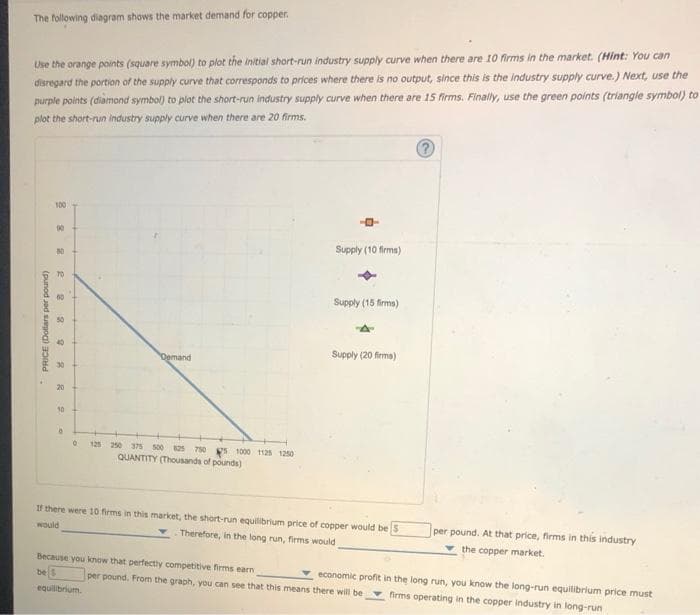The following diagram shows the market demand for copper. Use the orange points (square symbol) to plot the initial short-run industry supply curve when there are 10 firms in the market. (Hint: You can disregard the portion of the supply curve that corresponds to prices where there is no output, since this is the industry supply curve.) Next, use the purple points (diamond symbol) to plot the short-run industry supply curve when there are 15 firms. Finally, use the green points (triangle symbol) to plot the short-run industry supply curve when there are 20 firms. 100 00 Supply (10 firma) TO 60 Supply (15 firms) 50 40 Supply (20 firma) Demand 30 20 10 12 250 375 500 25 750 5 1000 1125 1250 QUANTITY (Thousands of pounds) If there were 10 firms in this market, the short-run equilibrium price of copper would be S would per pound. At that price, firms in this industry Therefore, in the long run, firms would the copper market. Because you know that perfectly competitive firms earn be s economic profit in the long run, you know the long-run equilibrium price must per pound. From the graph, you can see that this means there will be equilibrium. firms operating in the PRICE (Dollars per pound)
The following diagram shows the market demand for copper. Use the orange points (square symbol) to plot the initial short-run industry supply curve when there are 10 firms in the market. (Hint: You can disregard the portion of the supply curve that corresponds to prices where there is no output, since this is the industry supply curve.) Next, use the purple points (diamond symbol) to plot the short-run industry supply curve when there are 15 firms. Finally, use the green points (triangle symbol) to plot the short-run industry supply curve when there are 20 firms. 100 00 Supply (10 firma) TO 60 Supply (15 firms) 50 40 Supply (20 firma) Demand 30 20 10 12 250 375 500 25 750 5 1000 1125 1250 QUANTITY (Thousands of pounds) If there were 10 firms in this market, the short-run equilibrium price of copper would be S would per pound. At that price, firms in this industry Therefore, in the long run, firms would the copper market. Because you know that perfectly competitive firms earn be s economic profit in the long run, you know the long-run equilibrium price must per pound. From the graph, you can see that this means there will be equilibrium. firms operating in the PRICE (Dollars per pound)
Chapter12: The Partial Equilibrium Competitive Model
Section: Chapter Questions
Problem 12.6P
Related questions
Question

Transcribed Image Text:The following diagram shows the market demand for copper.
Use the orange points (square symbol) to plot the initial short-run industry supply curve when there are 10 firms in the market. (Hint: You can
disregard the portion of the supply curve that corresponds to prices where there is no output, since this is the industry supply curve.) Next, use the
purple points (diamond symbol) to plot the short-run industry supply curve when there are 15 firms. Finally, use the green points (triangle symbol) to
plot the short-run industry supply curve when there are 20 firms.
100
Supply (10 firms)
60
Supply (15 firms)
50
Supply (20 firma)
Demand
30
20
10
125
250 375 500 25 750 s 1000 1125 1250
QUANTITY (Thousands of pounds)
If there were 10 firms in this market, the short-run equilibrium price of copper would be S
would
per pound. At that price, firms in this industry
Therefore, in the long run, firms would
the copper market.
Because you know that perfecty competitive firms earn
be s
economic profit in the long run, you know the long-run equilibrium price must
per pound. From the graph, you can see that this means there will be firms operating in the copper industry in long-run
equilibrium.
PRICE (Dollars per pound)
Expert Solution
This question has been solved!
Explore an expertly crafted, step-by-step solution for a thorough understanding of key concepts.
This is a popular solution!
Trending now
This is a popular solution!
Step by step
Solved in 2 steps with 2 images

Recommended textbooks for you


Essentials of Economics (MindTap Course List)
Economics
ISBN:
9781337091992
Author:
N. Gregory Mankiw
Publisher:
Cengage Learning

Principles of Economics, 7th Edition (MindTap Cou…
Economics
ISBN:
9781285165875
Author:
N. Gregory Mankiw
Publisher:
Cengage Learning


Essentials of Economics (MindTap Course List)
Economics
ISBN:
9781337091992
Author:
N. Gregory Mankiw
Publisher:
Cengage Learning

Principles of Economics, 7th Edition (MindTap Cou…
Economics
ISBN:
9781285165875
Author:
N. Gregory Mankiw
Publisher:
Cengage Learning

Principles of Economics (MindTap Course List)
Economics
ISBN:
9781305585126
Author:
N. Gregory Mankiw
Publisher:
Cengage Learning


Economics (MindTap Course List)
Economics
ISBN:
9781337617383
Author:
Roger A. Arnold
Publisher:
Cengage Learning